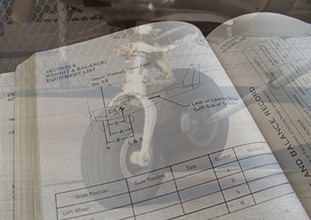 As you progress toward the private pilot checkride, your flight instructor may sometimes find it useful to play the role of designated examiner, observing and probing your knowledge of systems and procedures even during such routine phases of flight as your preflight inspection of your trainer.
As you progress toward the private pilot checkride, your flight instructor may sometimes find it useful to play the role of designated examiner, observing and probing your knowledge of systems and procedures even during such routine phases of flight as your preflight inspection of your trainer.
Today, as you ready the aircraft for a session practicing slow flight and stall recoveries, your eye is drawn to the 1980 Cessna 152’s nosewheel, which appears a little soft compared to how it usually rests on the ramp.
You mention your concern to the CFI, who responds with a question: “What is the proper tire pressure for this particular nosewheel tire?”
The question sends you burrowing into the pages of the aircraft’s pilot’s operating handbook for answers. There it is, in POH Section 8 (Handling, Service and Maintenance). The nosewheel tire should be inflated to 30 PSI (pounds per square inch) provided the standard four-ply 5.00-5 tire is installed.
Is it?
To find out, you backtrack to Section 6 (Weight and Balance/Equipment List) where the installed tires for the nosewheel and main gear are listed and described. The description includes such other details as the weight of the wheel-and-tire assembly, and its arm (in inches) which is a component in determining the aircraft’s center of gravity. At the CFI’s request, you explain that the arm is -10.8 inches.
"Why is the arm a negative number?"
Reading from the chapter’s notes, you respond that "positive arms are distances aft of the airplane datum; negative arms are distances forward of the datum."
This airplane is a hard-working trainer, making many takeoffs and landings each day. How do the nosewheel and main gear tires look generally?
Wear seems moderate, given the aircraft’s use and based on observation of the tires’ tread grooves. There are no visible cuts, scuffs, bulges, or wear patterns that would indicate that proper tire pressure has been neglected. A tire’s age may be betrayed by weather checking of the sidewalls, but that too seems absent. If fabric were showing through, it would be time to replace the tire, however.
Here’s another tip from tire pros: Tire damage from rough use can be confined to small areas, so be sure to perform a thorough examination, even if no obvious problem draws your attention to the landing gear during your preflight inspection.



